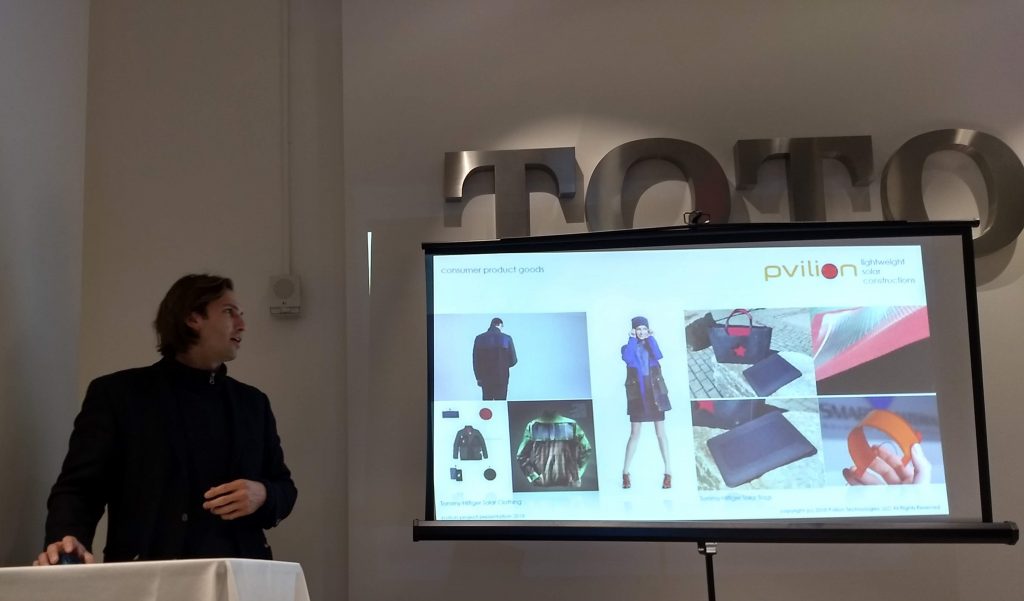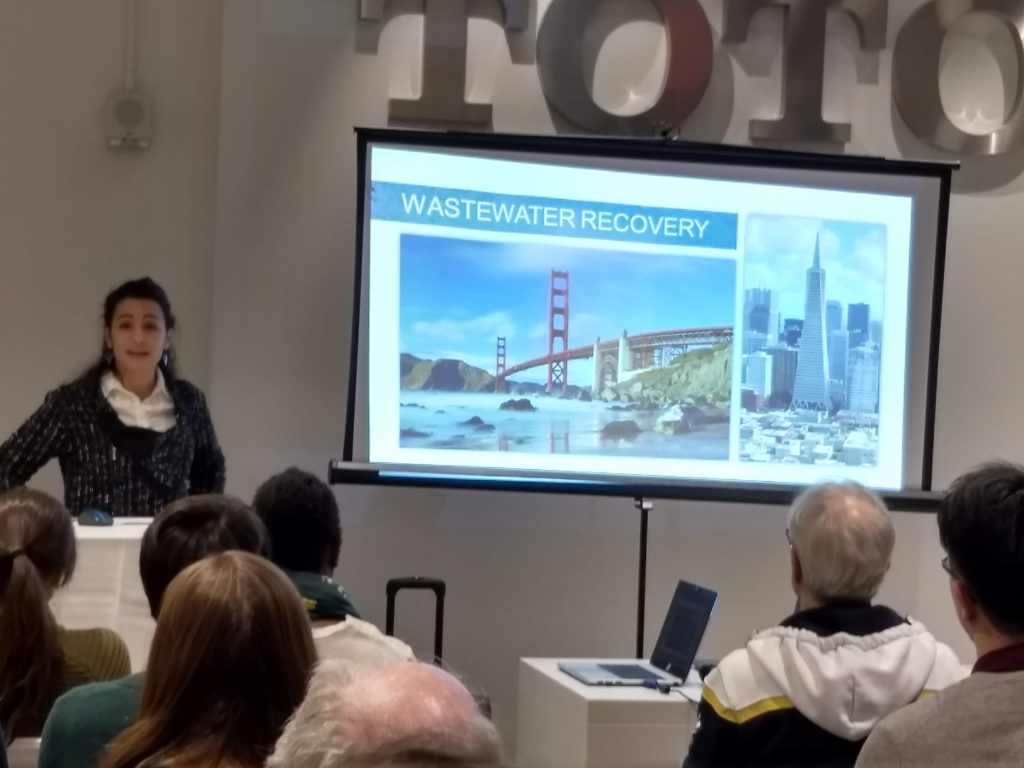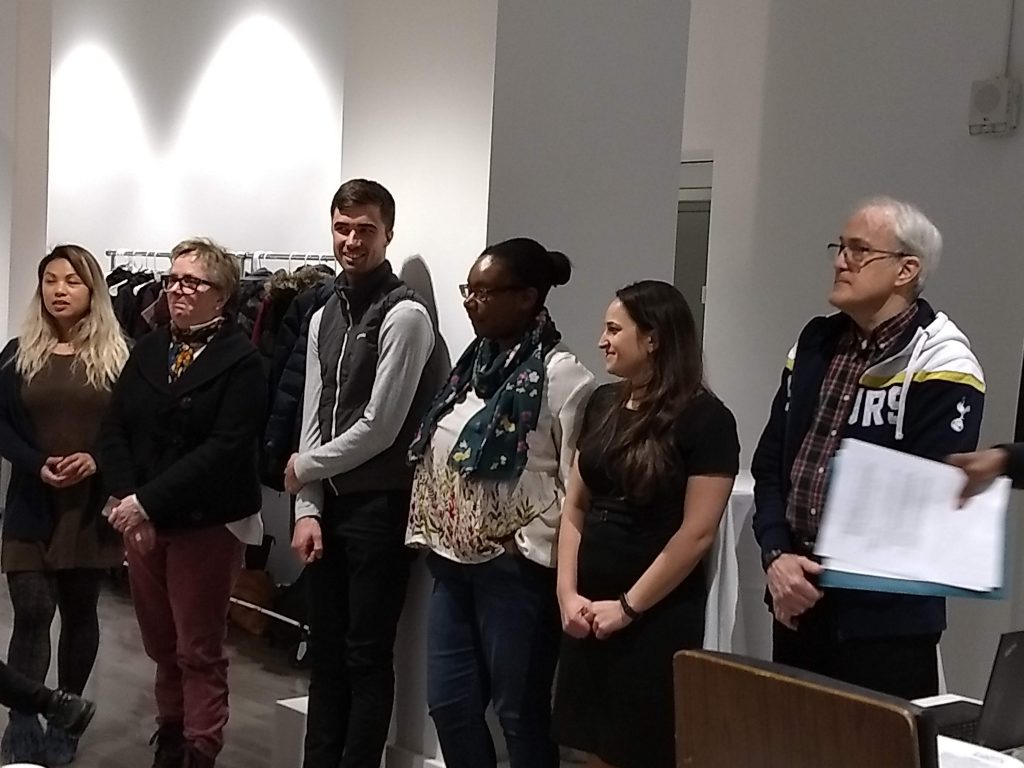Monthly Forum Recap: Green Catwalk 2019
January 30, 2019
By Jenny Dranetz, Photos by Dan Yafet
GreenHomeNYC kicked off 2019 with our classic Green Catwalk forum, highlighting new technologies, innovations and processes to address and combat climate change in the coming year and beyond. This year’s Catwalk featured six speakers from a host of industries, including solar, communications, and permaculture.
Presenting first was Colin Touhey, the CEO & Founder of Pvilion. Based out of Brooklyn, Pvilion designs, manufactures and installs flexible solar products. Pvilion thinks of solar as a cell, not a final product, and this view plus the flexibility of the cells has allowed them to take on creative, non-traditional solar projects, including curved building facades and other complex structures as well as clothing. These designs are self-sustaining and can be permanently built into a structure, such as on a façade or over a bridge like the Cascades Solar Pedestrian Bridge in Florida, or be installed temporarily for events like music festivals.
 Colin Touhey of Pvilion sharing some solar fashion
Colin Touhey of Pvilion sharing some solar fashionNext to speak was Kendra Pierre-Louis, a Climate Desk reporter with the New York Times. Kendra addressed exactly how she communicates with the public about climate change, especially these days when climate news tends to be a bit bleak. In addition to overcoming the challenges of readers’ disinterest in depressing news, Kendra faces writing to the “six Americas”, the six different climate-minded audiences that range from “dismissive” climate deniers to “alarmed” activists educated and engaged in the issues.
In the face of these challenges, Kendra advises first finding a hook, a line that’s interesting and draws the reader in, such as Kendra’s example of “Beavers Emerge as Agents of Arctic Destruction”. Second, Kendra suggests limiting jargon – remember who your audience is! Beyond drawing your audience in with the hook, Kendra thirdly recommends tapping into people’s interests throughout an article. Fourth, Kendra says it is okay to be honest about uncertainty and lastly, that it’s also okay to be a little weird! For example, Kendra’s “California’s Underwater Forests Are Being eaten by the ‘Cockroaches of the Ocean’” article was a unique look into the effects of climate change that piqued readers’ interests and curiosity to know exactly what are ‘Cockroaches of the Ocean’.
After Kendra, Leila d’Heurle, a design representative from TOTO USA, presented on water efficiency, defined as using the least amount of water necessary to get a job done. As a designer and manufacturer of toilets and other fixtures, TOTO’s mission includes protecting the environment by conserving natural resources and actively works to reduce their impact. With fresh water accounting for less than 3% of all water on the planet, many places in the US will be facing droughts by 2050. Knowing this, TOTO believes we should apply the concept of “Reuse, Reduce, Recycle” to water.
TOTO has consequently conducted Life-Cycle Assessments to identify where they can become more efficient and where resources can be reused, reduced or recycled. In completing the assessment, one of the lessons learned has been that simply changing packaging to a more space-efficient form has allowed for more items to ship per truckload, decreasing the number of shipments they need to make.
The average American uses 88 gallons of water per day, mostly in the bathroom, giving TOTO the opportunity to greatly impact and decrease water consumption. Switching fixtures over to low-flow ones is an easy way to become water-efficient and these changes become particularly impactful when done building-wide. For example, TOTO toilets only use 3.5 gallons/flush compared to the 6 gallons/flush of a traditional toilet. Buildings can also install systems that allow them to treat and reuse wastewater onsite and in fact, the city of San Francisco enacted a law in 2015 that requires that buildings of a certain square footage to install such treatment facilities onsite.
 Leila d’Heurle presenting TOTO’s philosophy and technology
Leila d’Heurle presenting TOTO’s philosophy and technologyNext, Christina Zawerucha spoke about her experience working with Green Path on permaculture projects in Ethiopia. Christina worked with local farmers to adopt environmentally preferable and organic agriculture techniques and to create market access to markets that value the crops being produced.
Christina’s projects increased produce yield by using methods that extend farmers’ growing season and taught them to farm in a modular way. This involved surrounding produce plants with perennials that also have uses and markets, such as lavender, to increase bio-diversity and create another source of income through a different market. Green Path further establishes a supply chain and access to these markets. For example, Green Path worked to open up the local avocado market, which was largely supplied by South American markets despite avocados being growing right there in Ethiopia. In opening up a market to local producers, Green Path ensures farmgate prices continue to incentivize positive behavioral changes.
Unfortunately, these projects can be difficult without Green Path as some communities lack the awareness of the benefits of modular and organic farming and are therefore not incentivized to switch. In communities where they do know and understand the value, the cost of organic certification is often prohibitively expensive. Despite this, Green Path has found success in the projects they have participated in so far. In monitoring their programs, 81% of participants now receive income when they did not previously and 42% say their quality of life has improved.
After Christina, Russell Wilcox then presented about his company, UrbnDER, which consults on and completes community solar projects. UrbnDER undertakes projects by leasing out roof space and exporting 100% of the electricity produced to ConEd’s grid and to subscribers, consequently making solar energy more accessible.
UrbnDER works on projects on multi-family and mixed-use buildings. For building owners, there is no cost – they simply lease out the roof and make use of space that was likely otherwise unused. UrbnDER then works with financiers to pay 20% of net install cost upfront. With financing and a lease in place, UrbnDER examines the space and determines the optimal set up to maximize energy production. For a project in Flatbush for example, a building from 1941 had unused dumb waiter shafts taking up part of the roof space. UrbnDER determined removing this equipment would increase the production of energy by 21%, significant enough to make it worth it to the team to take out.
Once energy is being produced, subscribers can sign up to receive the solar energy at a rate 10% cheaper than what they were previously paying for energy. Just like building owners, there is no cost to subscribers to join. With no cost and a reduced rate, UrbnDER make switching to solar energy more available and enticing.
Last to speak was Tom Sahagian, an independent energy-efficiency consultant.
In 2014, New York City established a goal to reduce GHG emissions by at least 80% by 2050 (80 x 50). One way to help achieve this goal in buildings is to convert traditional heating systems to heat pumps. Heat pumps are complicated, but on a basic level, they are like window AC units that can run “backwards” so that heat is moved from outdoors to inside.
There are four types of heat pumps: water to water, water to air, air to water, and air to air. Sahagian asserted that air-to-air systems were the most likely to help us reach the 80 x 50 goal.
Heat pumps often look like AC units on the outside but a heat pump also includes a reversing valve and other components necessary to permit “backwards” operation. Both ACs and heat pumps generally use the compression cooling cycle, in which a compressor provides the energy to move heat from one place to another. Sahagian described the cycle in detail.
Heat pumps are much more efficient than steam or hot water boilers. With steam boilers, on average 0.5 units of energy are produced for every 1 unit of energy that is put in. Older-technology heat pumps moved about 2 units for every 1, while new heat pumps can move 4 units for every 1. According to Tom, the transition to heat pumps is something we should have started a while ago and will be difficult to undertake, but they are still doable — and much-needed — conversions.
 Presenters and their colleagues during the Q&A
Presenters and their colleagues during the Q&A